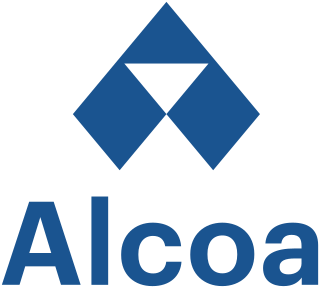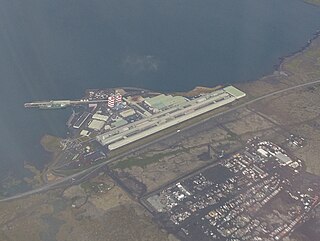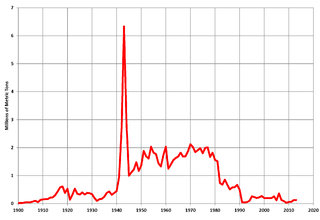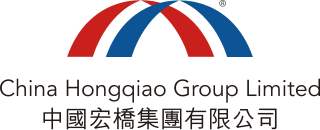The economy of Suriname was largely dependent upon the exports of aluminium oxide and small amounts of aluminium produced from bauxite mined in the country. However, after the departure of Alcoa, the economy depended on the exports of crude oil and gold. Suriname was ranked the 124th safest investment destination in the world in the March 2011 Euromoney Country Risk rankings.
Rio Tinto Alcan is a Canada-based mining company. Headquartered in Montreal, Quebec, it is a subsidiary of global mining conglomerate Rio Tinto. It was created on 15 November 2007 as the result of the merger between Rio Tinto's Canadian subsidiary and Canadian company Alcan.

Alcoa Corporation is a Pittsburgh-based industrial corporation. It is the world's eighth-largest producer of aluminum. Alcoa conducts operations in 10 countries. Alcoa is a major producer of primary aluminum, fabricated aluminum, and alumina combined, through its active and growing participation in all major aspects of the industry: technology, mining, refining, smelting, fabricating, and recycling.

Scrap consists of recyclable materials, usually metals, left over from product manufacturing and consumption, such as parts of vehicles, building supplies, and surplus materials. Unlike waste, scrap has monetary value, especially recovered metals, and non-metallic materials are also recovered for recycling. Once collected, the materials are sorted into types — typically metal scrap will be crushed, shredded, and sorted using mechanical processes.
Kaiser Aluminum Corporation is an American aluminum producer. It is a spinoff from Kaiser Aluminum and Chemicals Corporation, which came to be when common stock was offered in Permanente Metals Corporation and Permanente Metals Corporation's name was changed to Kaiser Aluminum and Chemicals Corporation.
Aluminum Corporation of China Limited, is a Chinese company listed in Hong Kong and in New York. A multinational aluminium company, its headquarters are in Beijing, People's Republic of China. It is the world's second-largest alumina producer and third-largest primary aluminium producer.

Aluminium recycling is the process by which scrap aluminium can be reused in products after its initial production. The process involves simply re-melting the metal, which is far less expensive and energy-intensive than creating new aluminium through the electrolysis of aluminium oxide, which must first be mined from bauxite ore and then refined into aluminium oxide using the Bayer process and then refined again into aluminium metal using the Hall–Héroult process.

The Anglesea Power Station was a brown coal–powered thermal power station located at Anglesea, in Victoria, Australia. The station had one steam turbine, with a capacity of 150 megawatts (200,000 hp). It was operated by Alcoa of Australia and supplied almost 40% of the electricity used by the company's Point Henry aluminium smelter, until the smelter's closure in August 2014.
Aluminium in Africa originates from bauxite, and within Africa is primarily found in Guinea, Mozambique and Ghana. Guinea is by far the biggest producer in Africa, and is a world leader in bauxite production.

United Company RUSAL, international public joint-stock company is the world's second largest aluminium company by primary production output. It was the largest until overtaken by China Hongqiao Group in 2015. UC RUSAL accounts for almost 9% of the world's primary aluminium output and 9% of the world's alumina production.

Volta Aluminum Company, known as VALCO, is an aluminium company based in Tema, Greater Accra Region founded by Kaiser Aluminum and now wholly owned by the government of Ghana.

Aluminium smelting is the process of extracting aluminium from its oxide, alumina, generally by the Hall-Héroult process. Alumina is extracted from the ore bauxite by means of the Bayer process at an alumina refinery.

The Mining industry of Ghana accounts for 5% of the country's GDP and minerals make up 37% of total exports. Gold contributes over 90% of the total mineral exports. Thus, the main focus of Ghana's mining and minerals development industry remains focused on gold. Ghana is Africa's largest gold producer, producing 80.5 t in 2008. Ghana is also a major producer of bauxite, manganese and diamonds. Ghana has 20 large-scale mining companies producing gold, diamonds, bauxite and manganese; over 300 registered small scale mining groups; and 90 mine support service companies.Other mineral commodities produced in the country are natural gas, petroleum, salt, and silver.
Industry in Ghana accounts for about 24.5% of total GDP. However, Ghana's industrial production is rising at a 7.8% rate, giving it the 38th fastest growing industrial production in the world due to government industrialization policies.
Sulfur production in the United States was 9.04 million metric tons of sulfur content in 2014, all of it recovered as a byproduct, from oil refineries, natural gas processing plants, and metal smelters. The United States was second in the world in sulfur production in 2014, behind China. The sulfur recovered was marketed in the forms of native (elemental) sulfur, and sulfuric acid. Total value was US$927 million in 2014.

Zinc mining in the United States produced 780,000 tonnes of zinc in 2019, making it the world's fourth-largest zinc producer, after China, Australia, and Peru. Most US zinc came from the Red Dog mine in Alaska. The industry employed about 2,500 in mining and milling, and 250 in smelting.

Bauxite mining in the United States produced an estimated 128,000 metric tonnes of bauxite in 2013. Although the United States was an important source of bauxite in the early 20th century, it now supplies less than one percent of world bauxite production.

China Hongqiao Group Limited is a company founded in 1994 that specializes in the production of aluminium. Hongqiao is currently the second largest aluminium producer in the world after Chinalco. It is listed on the Hong Kong Stock Exchange with stock code 1378, and is incorporated in George Town, Cayman Islands.

Aluminum is the third most abundant element in the lithosphere at 82,000 ppm. It occurs in low levels, 0.9 ppm, in humans. Aluminum is known to be an ecotoxicant and expected to be a health risk to people. Global primary production (GPP) of aluminum was about 52 million tons in 2013 and remains one of the world's most important metals. It is used for infrastructure, vehicles, aviation, energy and more due to its lightweight, ductility, and cheap cost. Aluminum is harvested from gibbsite, boehmite, and diaspore which make up bauxite. The aluminum cycle is the biogeochemical cycle by which aluminum is moved through the environment by natural and anthropogenic processes. The biogeochemical cycle of aluminum is integral with silicon and phosphorus. For example, phosphates store aluminum that has been sedimented and aluminum is found in diatoms. Aluminum has been found to prevent growth in organisms by making phosphates less available. The humans/lithosphere ratio (B/L) is very low at 0.000011. This level shows that aluminum is more essential in the lithospheric cycle than in the biotic cycle.

Compagnie des bauxites de Guinée (CBG) is a Guinean mining company. Since 1963 it has extracted bauxite from the notable mine in Sangarédi, in Boké Region in Guinea. It is 49% owned by the Guinean State, with the remainder owned by the Boké Investment Company, a 100%-owned subsidiary of Halco Mining, a consortium opened in 1962 by Harvey Aluminum Company to run mining operations in Guinea. Halco's stock is owned by Alcoa (45%), Rio Tinto Alcan (45%) and Dadco Investments (10%).














